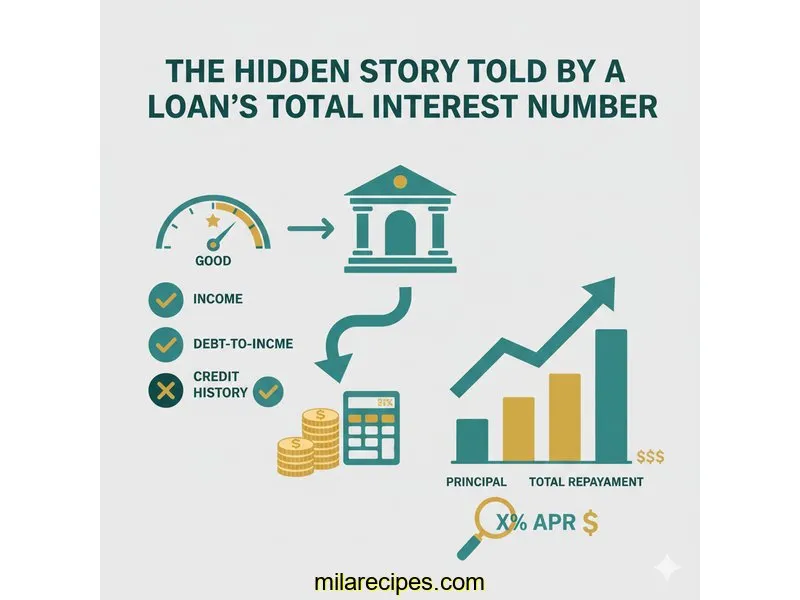
Auto Loan Calculator
Calculate payments over the life of your Loan
Home Blog Privacy Terms About Contact
Calculate payments over the life of your Loan
Home Blog Privacy Terms About ContactPublished on October 26, 2025

It all began with a simple conversation. My cousin and I were both planning some home improvement projects, and we found ourselves looking at similar personal loan amounts. During a weekend chat, he mentioned a rate he’d seen that came with a surprisingly low monthly payment. I remember my initial reaction was a mix of surprise and a little bit of envy. How was his potential payment so much lower than what I was seeing for roughly the same amount?
But then a question started to form in my mind, a little bit of static that I couldn't ignore. If the loan amounts were similar and the interest rates were in the same ballpark, how could one payment be significantly smaller? There had to be a mathematical reason, a variable I was overlooking. It felt like trying to solve a puzzle with a missing piece. Was a lower payment truly a better deal, or was there another number telling a different story?
This curiosity sent me down a path of exploration. I wasn't trying to find the "best" loan; I just wanted to understand the mechanics behind the numbers. My goal was simple: to figure out why his monthly payment was lower and what that meant for the overall structure of the loan. I started playing with some online loan calculators, plugging in numbers, but my focus was narrow. I was fixated on that one field: the monthly payment. It felt like the only number that mattered, but the math just wasn't adding up in a way that made sense to me. This is the story of how I learned to look past that one number and understand the bigger picture. This is about understanding how calculations work, not financial advice.
My first step was to try and replicate the scenarios using a basic online calculator. I wanted to see the numbers side-by-side. I decided to use a hypothetical loan amount of $13,850 and an interest rate of 7.2% for both scenarios, just to keep the comparison clean. My initial thought was to see how a shorter term, say 48 months, would play out.
I carefully entered the data: $13,850 for the loan amount, 7.2% for the annual rate, and 48 for the term in months. The calculator instantly returned a monthly payment of around $335.78. That felt straightforward enough. This was my baseline, the number I had in my head as a reasonable payment for that kind of loan.
Then, I tried to figure out my cousin’s scenario. Since his payment was lower, I guessed he must have been looking at a longer term. I kept the loan amount and interest rate the same but changed the term to 72 months. The result was a monthly payment of $238.16. My first reaction was, "Wow, that's nearly $100 less per month!" My brain immediately jumped to the conclusion that his situation was better. A hundred dollars is a hundred dollars, right?
But the feeling of a missing piece lingered. I stared at the two results on my screen. How could the same amount of money, at the same interest rate, have such different outcomes? My mistake was that I was treating the monthly payment as the finish line. I completely ignored the other outputs the calculator was showing me—fields like "Total Principal Paid," "Total Interest Paid," and "Total of Payments." They were just extra numbers to me, background noise behind the main event. My singular focus on the monthly figure was blinding me to the real story the math was trying to tell me.
The frustration of not quite getting it led me to just sit and stare at the calculator's results page. Instead of running new numbers, I forced myself to read every single line of the output for both my 48-month scenario and the 72-month one. My eyes drifted past the monthly payment and landed on a field I’d been ignoring: "Total Interest Paid." That's when everything clicked into place.
For the 48-month term, the total interest was $2,267.44. For the 72-month term, the total interest was $3,297.52. It was a difference of over a thousand dollars. Suddenly, the lower monthly payment didn't seem so appealing. It came at a significant long-term price. The "better deal" was an illusion created by looking at only one variable. The real story was in the total figures, not the monthly ones. This was my breakthrough moment—realizing that every number in a loan calculation is part of an interconnected system.
Once I had my "aha" moment, the underlying math became much clearer. The monthly payment is fundamentally the total amount you need to repay (principal plus all future interest) divided by the number of months in your term. When you stretch that denominator from 48 to 72, the resulting monthly figure naturally gets smaller, even though the total interest in the numerator has increased.
This was the most crucial part of my understanding. Interest isn't a one-time fee. It's calculated periodically (usually monthly) on the outstanding loan balance. With a 72-month loan, there are 24 extra months during which interest is being calculated compared to a 48-month loan. Even though the principal is decreasing with each payment, the longer timeline provides more opportunities for interest to accrue on the remaining balance.
To really solidify this, I found a calculator with an amortization schedule feature. I plugged in the 72-month scenario and looked at the first payment of $238.16. The schedule showed that about $83.10 went to interest and only $155.06 went to principal. In contrast, the first payment of $335.78 on the 48-month loan had the same $83.10 in interest, but $252.68 went to principal. Seeing that stark difference in how much principal was being paid down each month was the final visual proof I needed.
To test my new understanding, I ran a third scenario right in the middle: a 60-month term. As I predicted, the numbers fell perfectly between the other two. The monthly payment was about $278.41, and the total interest was $2,854.60. This test confirmed that I wasn't just observing a fluke; I was understanding the predictable, mathematical relationship between term, payment, and total interest.
This journey, which started with a simple question about a monthly payment, taught me so much about the mechanics of loan calculations. It wasn't about making a decision, but about gaining literacy in how these numbers interact. Here are the key lessons I took away about the calculations themselves:
This is a common point of confusion. That calculation would be for "simple interest" over a single period. Most loans, like personal or auto loans, use an amortizing formula where interest is calculated on a declining balance over many periods. Each month, you pay interest only on what you still owe, not the original amount, which is why a complex formula is needed to determine the total.
The term acts as a multiplier on the number of interest calculations. A 72-month loan has 24 more periods where interest accrues than a 48-month loan. While the principal balance is shrinking, it shrinks more slowly on a longer loan, meaning the balance remains higher for longer, giving the interest rate more to "bite" into over time.
If you are comparing two scenarios with the same loan amount and interest rate, the "Total of Payments" is the most revealing number. It represents the grand total you will have paid by the end of the loan. A close second is the "Total Interest Paid," which clearly shows the direct borrowing price of each scenario.
An amortization schedule is a payment-by-payment breakdown. It shows you exactly how much of each monthly payment is allocated to interest versus how much goes to reducing your principal balance. It's the most transparent view of how your loan is paid off over time and visually demonstrates how payments initially cover more interest than principal.

My biggest takeaway from this entire exercise was a simple but profound one: the most prominent number isn't always the most important one. The low monthly payment that initially caught my attention was, in a way, a distraction from the more telling figure—the total interest paid. Learning to look beyond the surface and understand the relationship between all the variables was incredibly empowering.
It transformed my view of financial calculators from simple answer machines into powerful learning tools. They allow you to experiment with numbers in a safe environment and see for yourself how changing one input can dramatically alter the outcome. It's a hands-on way to build financial literacy that no textbook could ever replicate.
I hope sharing my personal journey of curiosity and discovery encourages you to do the same. Play with the numbers, ask "what if," and seek to understand the mechanics behind the math. The confidence that comes from understanding how these calculations work is a valuable thing to have.
This article is about understanding calculations and using tools. For financial decisions, always consult a qualified financial professional.
Disclaimer: This article documents my personal journey learning about loan calculations and how to use financial calculators. This is educational content about understanding math and using tools—not financial advice. Actual loan terms, rates, and costs vary based on individual circumstances, creditworthiness, and lender policies. Calculator results are estimates for educational purposes. Always verify calculations with your lender and consult a qualified financial advisor before making any financial decisions.
